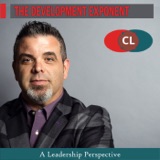
The Development Exponent: A Leadership Perspective
Bruce Holoubek
Podcast
Episodes
Listen, download, subscribe
Why Your Strategic Planning Framework Should Foster Mutually Meaningful Work Engagements with Michelle Neujahr
There are many strategic planning frameworks out there, but how many of them have as a key component, an emphasis on building mutually meaningful work engagements? From my point of view, this is an oft missing but vital piece of the planning that organizations of any size should be doing. What does it matter if the strategic planning framework you choose is the latest and greatest but your team members don’t feel it provides a way for them to be actively and enthusiastically involved in its implementation? My guest on this episode is a business consultant who has found her sweet spot in helping businesses work out strategic plans that not only help the company refine its vision for what it delivers and for whom, but also to communicate and implement the plan in a way that energizes team members. Michelle Neujahr is the founder of Nu-Yar, a no-nonsense business consulting company that works with committed business owners and executive teams. The experience she draws upon in helping leaders comes from being a real-world business owner herself. The heart of any good strategic planning process is not in the organization of the “planning event” itself or even in the slogans or campaigns devised from the discussion. The heart of real and powerful strategic planning is the people who will implement that plan. Getting them engaged and vested in the plan is the missing piece for most companies. Symptoms that your organization may need to develop a strategic plan? Michelle points out that the symptoms that indicate the need for effective strategic planning can be varied. Not only that but every organization — due to its unique history and culture — will manifest the need for a comprehensive strategic plan in equally unique ways. Some of the most common indicators that strategic planning is needed are things such as revenue plateaus, internal systems that are outdated or that no longer work, or a lack of clarity about where the organization is going and why. I believe that even though plateaus and broken systems are perhaps the leading indicators of the need for strategic planning, there is another fairly common occurrence that is symptomatic of a more vital problem — poor morale among the organization’s team. Work engagements that make a difference are not only those that turn a profit for the organization or enable it to reach its corporate goals. The thing that matters even more is the health and happiness of all the “cogs” in the inner workings of the organizational machinery. If they are not well lubricated, then those cogs (team members) who are unhappy or unfulfilled will eventually break, which will cripple the entire organizational machine. Strategic planning is about more than an annual revision of goals While organizations definitely need to revisit goals they have previously set to assess whether the goals were accomplished and/or whether they should have been set in the first place, that is not the focus of strategic planning. Strategic planning is aimed at a bigger target. Its objective is to set the course for the organization and to disseminate that direction throughout the organization’s team members in actionable ways. Sadly, it’s that last part that is missed in strategic planning much of the time. Vision and direction are great, but only if those who are expected to make it happen understand it and are on board with making it happen. Leadership development as part of the strategic planning framework Smaller organizations often discover that in the rush and hurry that often accompanies rapid growth they have simply been scrambling to keep their heads above water. This means they’ve hired friends or relatives, have patched up systems and processes on the fly at times, and in other words have done whatever was necessary to keep the business running. But as they grow, they begin to realize that the rush to meet customer demands without much thought for long-term strategy has put them into a difficult position. For example, startup founders often discover that once the company is profitable and in need of growth, it can’t grow because roles are not clearly defined, systems are not optimized or well-implemented, and long-tenured team members may not be in the right positions to enable the business to move forward. This is where strategic planning needs to be done. It enables the organization to move toward the future in positive ways, and an important part of that strategic planning framework needs to include the development of leaders to fill key roles that will be needed as the business grows. An organization can only rise to the level of its leaders, so preparing for growth means equipping future leaders ahead of time. Communicating strategic plans to your team in personal ways As mentioned previously, strategic plans will only be effective long-term when the plan is one that the team implementing the plan is enthused about and vested in. Building culture and values that serve the team as well as the customer is not easy, but it’s vital — and doing so in a way that is integrated into the “what and how” of the strategic plan is difficult at best. It can be accomplished better when the team is consulted at the outset of the strategic planning process. Those who fill the roles that will carry out the plan — from customer service and sales professionals, all the way to the back-office administrative help — need to be asked for their input regarding the things that are holding the company back, what is stifling its ability to flourish, and on a more personal note, how their happiness is affected by the working environment of the organization. When this kind of sharing is received and taken seriously, the right kind of forward motion can take place through the planning process. It’s recommended that strategic plans, once complete, be simplified. Boil the themes down to their most essential components that can be easily understood. Then tie those things to the initial input team members provided. When the team can hear leadership say, “You told us X, so we decided to do Y to solve for that,” they will actually be hearing, “You matter. Your opinion about what we’re doing as a team matters. You are a valuable part of this team and you’re making a difference.” Listen to hear how Michelle has helped organizations walk the strategic planning path, engage team members in it, and enlist them in implementation. Outline of This Episode [3:15] Michelle’s life and business journey [10:28] The typical client Michelle serves — and why it’s her sweet spot [17:24] Common roadblocks to the strategic planning process [21:40] The need for leadership development in the strategic planning process [27:02] Communicating strategic plans in personal ways Resources & People Mentioned Zig Ziglar Norman Vincent Peale Les Brown Connect with Michelle Neujahr Michelle’s coaching website: https://nu-yar.com/ Follow Michelle on LinkedIn Follow Michelle on Twitter: @michelleneujahr Connect With Bruce www.ContractedLeadership.com Facebook LinkedIn Twitter Subscribe to The Development Exponent Audio Production and Show notes by PODCAST FAST TRACK
The Development Exponent: A Leadership Perspective RSS Feed

